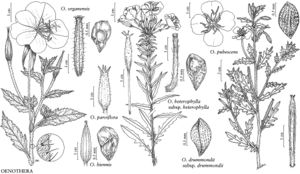Oenothera drummondii subsp. drummondii
Herbs annual, densely strigillose, sometimes also villous, also glandular puberulent distally. Stems erect to decumbent, with nonflowering lateral branches, these often with terminal rosette of crowded, small leaves, 10–50 cm. Leaves in a basal rosette and cauline, basal 5–14 × 1–2 cm, cauline 1–8 × 0.5–2.5 cm; blade grayish green, narrowly oblanceolate to elliptic, becoming elliptic to narrowly obovate to obovate distally, margins subentire or shallowly dentate; bracts spreading, flat. Flowers 1–few opening per day near sunset; buds erect, with free tips erect, 1–3 mm; floral-tube 25–50 mm; sepals 20–30 mm; petals yellow, very broadly obovate or obcordate, 25–45 mm; filaments 10–23 mm, anthers 4–12 mm, pollen 85–100% fertile; style 35–75 mm, stigma exserted beyond anthers at anthesis. Capsules cylindrical, sometimes slightly enlarged toward apex, 25–55 × 2–3 mm. Seeds usually ellipsoid to broadly ellipsoid, rarely subglobose, 1–2 ×0.5–0.9 mm. 2n = 14.
Phenology: Flowering Jan–Dec.
Habitat: Along or near Atlantic coast on dunes and open sandy places.
Elevation: 0–10 m.
Distribution
Along or near Atlantic coast on dunes and open sandy places, Fla., La., N.C., S.C., Tex., Mexico (Tamaulipas), Mexico (Veracruz), in South America, sw Europe, Asia (including Taiwan), Africa, Australia
Discussion
Collections of subsp. drummondii at inland localities in Bexar and Dallas counties, Texas, and Henderson County, North Carolina, presumably represent introductions; it is also widely naturalized and is known from Africa, Asia, Australia, southwestern Europe, South America, and Taiwan (W. Dietrich and W. L. Wagner 1988; Wagner et al. 2007).
Selected References
None.
